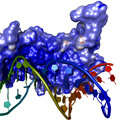Through a cell biology lens, the study of gene expression is tightly linked to our understanding of proteins. Since the early work of Christian Anfinsen in the 1950s, we know that the sequence of amino acids in a protein determines its final three-dimensional structure. Following from that, scientists have repeatedly observed that protein structure dictates where it will act and what it will do. Nowhere has this been more obvious than with the function of enzymes. The shape and structure of proteins is a crucial aspect of gene expression biology and links our understanding of gene expression to the biology of the cell. While primarily concerned with protein molecules that act on DNA and RNA sequences, such as transcription factors and histones, the study of gene expression also focuses on where in the cell expression is modulated. In fact, the modulation of gene expression can occur in the nucleus, the cytoplasm, or even at the cell membrane due to the impact of proteins on RNA in those cellular subregions.
How do scientists study protein shape and function? A technique called mass spectrometry permits scientists to sequence the amino acids in a protein. After a sequence is known, comparing its amino acid sequence with databases allows scientists to discover if there are related proteins whose function is already known. Often similar amino acid sequences will have similar functions within a cell. The amino acid sequence also allows scientists to predict the charge of the molecule, its size, and its probable three-dimensional structure. The charge and size can later be confirmed experimentally (via SDS-PAGE and double-dimension gels). To deduce the intricacies of three-dimensional structure, scientists will try to crystallize the protein to confirm its molecular structure through X-ray crystallography and/or nuclear magnetic resonance spectroscopy (pNMR).
How do scientists study the impact of proteins on genes or other proteins? A good way to study the function of the protein is to see what happens in the cell when the protein is not present. For this scientists use model systems, such as cell culture or whole organisms, wherein they can test the function of specific proteins or genes by modifying or mutating them. The expression level of a gene can be calculated by measuring the transcribed mRNA (northern blot), the expressed protein (Western Blot), or by directly staining the protein or mRNA when it is still in the cell. New techniques have changed the way we study gene expression — DNA microarrays, serial analysis of gene expression (SAGE), and high-throughput sequencing allow larger screens of multiple molecules simultaneously and have opened up the possibility of new and broader kinds of questions. To analyze large datasets and see how networks of molecules interact, a new discipline called systems biology provides the framework for these larger and more integrated understandings of regulatory networks.
Interestingly, proteins are not the only gene regulators. Regulatory molecules come in the form of RNA and act on other nucleic acids by changing or disrupting them. One example is the family of riboswitches, ribonucleic acid molecules that form three-dimensional structures that halt or interfere with transcription, given the proper external signal. Another example of RNA acting on other RNA is the mechanism of RNA interference (RNAi), whereby double-stranded RNA molecules degrade mRNA before translation, thus effectively interfering with protein expression. The dissection of this mechanism and its subsequent experimental imitation has been a boon to those interested in manipulating gene function.
Ultimately, results from these kinds of studies have fundamental relevance, from the basic understanding of normal cell function, such as cell differentiation, growth, and division, to informing radically new approaches for treating disease. In fact, some human diseases can arise simply from a defect in a protein's three-dimensional structure. Through the study of gene expression and proteins, it is easy to see how minute changes at the molecular level have a reverberating impact.




